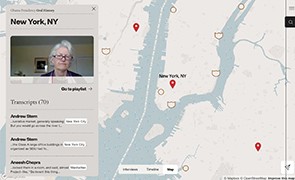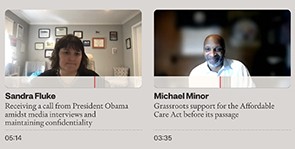The Obama Administration’s Approach to Healthcare Reform, From the Outside In
The Obama Presidency Oral History releases 26 new interviews and 400 new stories related to healthcare reform on an innovative new website.

This week, coinciding with the 14th anniversary of the Patient Protection and Affordable Care Act (ACA) being signed into law, Columbia University’s Incite Institute released 26 new interviews from the Obama Presidency Oral History.
The interviews, available on the project’s website, tell the story of the ACA, from inception to passage to implementation, through the voices of White House officials and advisors, congressional staff, industry and civil society leaders, union members, and extraordinary citizens.
This release is the project’s first since May 2023, when 17 interviews related to climate, the environment, and energy were released and a panel discussion was held in New York City. The Obama Presidency Oral History makes visible the dialogic relationships of power—between those who wield it, and those who influence and experience it—in shaping policy and American life.
“The ACA is an extraordinary achievement that changed the lives of tens of millions of Americans,” says the project’s Principal Investigator, Peter Bearman. He added, “How that happened is important to understand and this study tells that story.”
A Rubik’s Cube of Negotiations
In a press briefing on March 20, 2024, Associate Research Scholar Evan McCormick reinforced that the unique, expansive design of this project is critical to understanding healthcare reform. He cited an interview with White House Deputy Chief of Staff Nancy-Anne DeParle, in which DeParle recalls President Obama using a Rubik’s Cube as a metaphor.
“The president used to make this motion—I think I have one of these on my desk somewhere. Yes. Here it is. He used to make this motion [twists hands], and without having a real Rubik’s Cube, he’d say, 'It’s like we’ve just got to get each—you know, there’s so many moving parts. We’ve just got to get them to click into place.'
And I remember thinking, yes, Mr. President, and you’re so smart, you probably could do [laughs] the Rubik’s Cube, but I can’t. And every time I move the orange, the blue—I think I’ve got the two orange ones lining up, and then the blue shoots in there, and I can’t fix it. But there were a lot of days like that, where you get two things to agree, and then the other one would be a problem.”
“Seeing the ACA from the inside-out and the outside-in makes it possible to understand the complex process by which the law came to be, and what it means to Americans more than a dozen years later,” McCormick said.
This latest release includes interviews with union leaders Andy Stern (SEIU) and Richard Trumka (AFL-CIO), former Planned Parenthood President Cecile Richards, National Medical Association President Carolyn Britton, and American Medical Association President Nancy Nielsen, all of whom had a role in shaping the ACA.
Moreover, the release highlights the engaged citizens whose actions influenced the presidency, including Connie Anderson, who, with her sister, became a face of the ACA, Jim Houser, an Oregon auto shop owner turned healthcare advocate, and Michael Minor, a pastor who fought to expand healthcare access in Mississippi.
Breakthroughs in Digital Oral History Presentation
When the Obama Presidency Oral History began releasing interviews last year, its website was praised for pushing the envelope on accessibility and user-friendliness. With this latest release, Incite, an interdisciplinary social science research institute at Columbia, has unveiled several new innovations that represent breakthroughs in how oral histories are made available online.

A core innovation is the development of stories—moments in interviews that are identified from instances where narrators discuss a common topic, person, policy, place, or organization at length. Using a combination of close reading and statistical methods, Incite has identified thousands of stories and their overlaps, allowing users to easily explore and compare different perspectives. More than 1,700 of these stories are now available for the first time.

The stories are used as building blocks for several new features, including a timeline, map, and playlists. In addition, these stories are used to index oral history interviews, allowing users to more deeply engage with key interview moments.
“These innovations help make oral history interviews more navigable than ever and help visitors surface stories, make comparisons, and explore issues from a multitude of perspectives,” said Chris Pandza, who spearheaded the project’s public-facing design in collaboration with the award-winning creative agency Huncwot, natural language processing expert Jean-Philippe Cointet from Sciences Po, and Incite’s internal research team. The design aims to provide a user experience that is accessible to broad audiences and provides many entry points for people from all walks of life.
As the Obama Presidency Oral History archive grows, more features will come online.